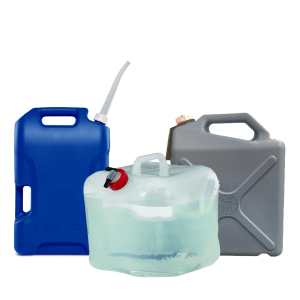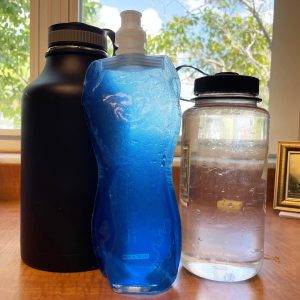Para acceder a esta comunicación en español, por favor utilice este enlace
Water is an essential consideration during a natural disaster such as a Hurricane or Tropical Storm. If you’re reading this while a storm is in the forecast for your area, then scenes of bare shelves in your local grocery stores are either all over the news or coming soon. But with abundant safe tap water in our homes today, do we really need to hoard gallon jugs of water from the supermarket?
No, we don’t.
Pre-packaged bottled water is a good option if you can find it or if you bought it at the beginning of the hurricane season. But, if you can’t find any or want an alternative what should you do?
Alternatives to Buying Gallons of Water at the Local Supermarket
Non-Potable Water Storage (Non-Potable = Not Safe for Drinking)
Long-term Floridians will be the first to tell you, “Fill your bathtub with water.”

This is a great idea for residents on a private or personal well system as their water pump will not work in the event of a power outage. Storing water like this is a great way to prepare for water uses that don’t require potable water (potable = clean drinking water) such as flushing the toilet. You can also fill cleaned and sanitized spare garbage cans or storage tubs and keep them in your shower or bathroom.’
Never wash your dishes, wash your hands, brush your teeth, or wash your face with non-potable water. If you wouldn’t drink it, don’t use it near your mouth, eyes, or nose or any surface that will contact any of those areas (like a toothbrush!).
Potable Water Storage (Potable = Safe for Drinking)
Storing safe drinking water is a bit more complicated, but it can be done. Use only food-grade containers for storing water to avoid contaminating your emergency water source. Water storage containers are available in the hunting and camping section of many local retailers. If you cannot find storage containers designed specifically for water storage, try to choose durable containers with a narrow opening (for easy pouring) and a tight-fitting lid.
You want to ensure you have cleaned and sanitized containers with tight-fitting lids. The following information on how to sanitize containers for water storage comes directly from the Centers for Disease Control and Prevention (CDC):
- Sanitize the container with a solution made by mixing 1 teaspoon of unscented liquid household chlorine bleach in 1 quart of water. Use bleach thatcontains 5%–9% sodium hypochlorite.
- Cover the container tightly and shake it well. Make sure the sanitizing bleach solution touches all inside surfaces of the container.
- Wait at least 30 seconds and then pour the sanitizing solution out of the container.
- Let the empty sanitized container air-dry before use OR rinse the empty container with safe water (water that has been treated).
- Pour clean water into the sanitized container and cover with a tight lid.
If the container has a threaded lid, like a Nalgene-style bottle or Hydroflask, be sure to “bleed the threads” with the sanitizing solution. This means making sure the sanitizing liquid is poured over and through the threaded areas. To properly “bleed the threads”, loosen the lid and pour the sanitizing liquid, through openings under the lid, while rotating the bottle to ensure all areas are sanitized.
How to bleed the threads
This example of bleeding the threads is from a camping and backpacking tutorial on water purification. You can ignore that part of the video and focus on the physical example of bleeding the threads shown.
Water Storage Containers Commonly Found in Households
If you can’t find storage containers at local stores for water, consider these containers commonly found in households:
- Personal re-usable water bottles: Any personal water bottles you may have are appropriate for water storage! Metal, plastic, glass, etc … will all work. Be sure to sanitize the drinking spout or bite-valve, if it has one.
- Previously used Water dispenser jugs: 5 gallons, 2.5 gallons, or one gallon

Generally speaking, avoid using plastic milk jugs. They can be used if no alternative is available. Milk jugs have a lot of nooks and crannies that are challenging to properly sanitize. If using plastic milk jugs, use extra care during the sanitizing step of the process!
Never use a container that has been used to store household chemicals, pesticides, or fertilizers to store water.
How Long Can I Safely Store Water?
Water kept in containers that have been properly sanitized can be stored for up to 6 months if stored with tightly fitting lids.
Try to store this water away from direct sunlight, in a cool location, and away from possible contaminants like pesticides or household chemicals.
If the container is not easy to pour from or doesn’t have a spout, make sure to sanitize the tool you use to scoop out water before each use. Avoid touching the inside of the container or lid when removing water.
Once a water storage container has been opened, drink or use all the water within 24-48 hours to ensure the water is safe.
How Much Water To Store?
The standard advice is to store enough water for each person to have 1 to 1.5 gallons per day. In Florida’s heat, you may want to store more if you have space and available containers. Consider increasing the amount stored if there are children, sick people, and/or nursing mothers in the home.
Don’t forget pets! If you have pets, store a quart to a gallon per pet per day, depending on its size.
You should store a minimum 3-day supply of water. If you have the space for it, consider storing a two-week supply.
Sources:
- https://edis.ifas.ufl.edu/publication/ss439
- https://www.cdc.gov/healthywater/emergency/creating-storing-emergency-water-supply.html?CDC_AA_refVal=https%3A%2F%2Fwww.cdc.gov%2Fhealthywater%2Femergency%2Fcleaning-preparing-storage-containers.html
- https://www.cdc.gov/disasters/foodwater/safe-water.html
- https://www.epa.gov/ground-water-and-drinking-water/emergency-disinfection-drinking-water
 4
4
